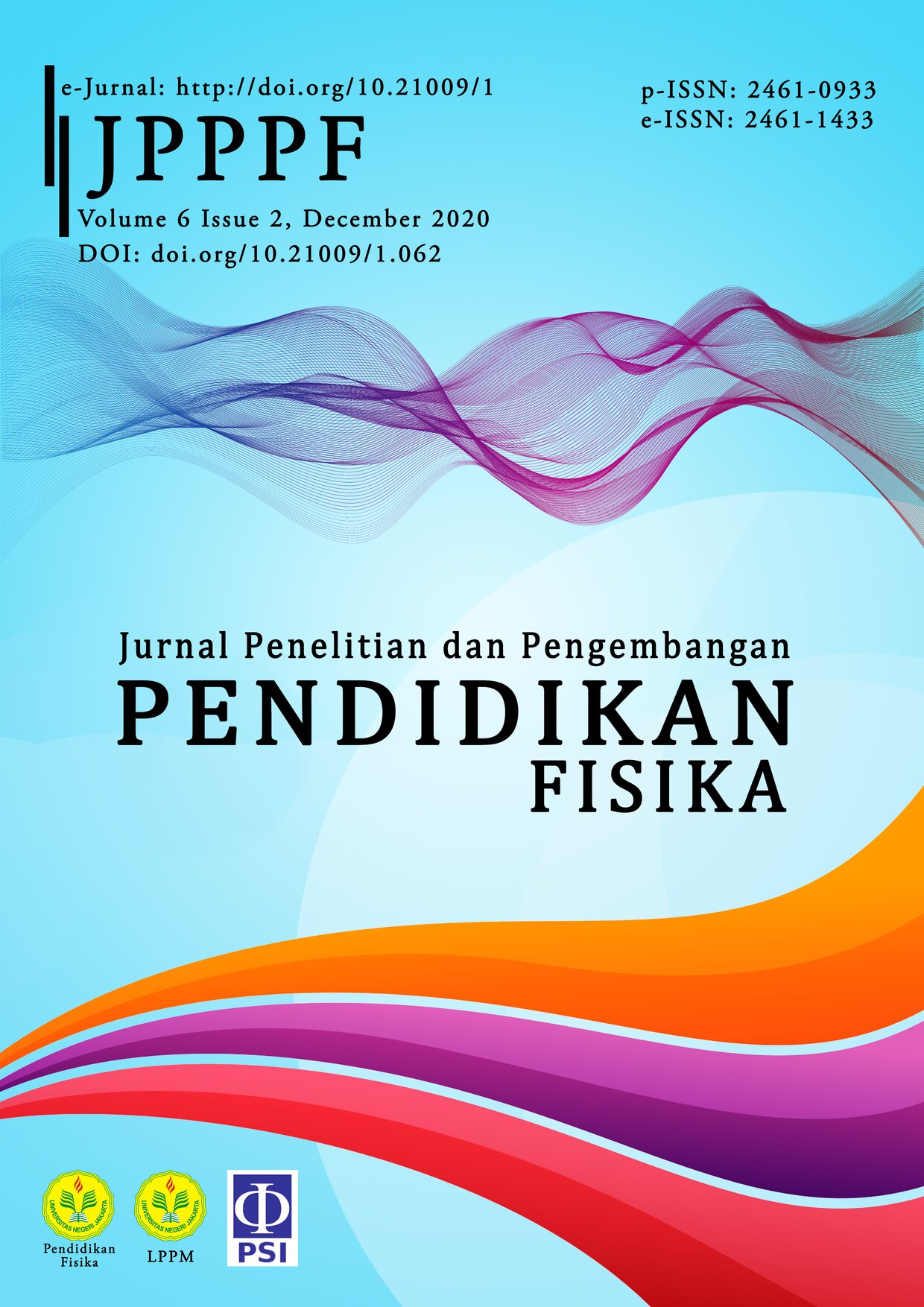Moodle-based E-Learning Model for Critical Thinking in the Lesson of Electromagnetic Induction
DOI:
https://doi.org/10.21009/1.06210Keywords:
e-learning, moodle, instructional design, critical thinkingAbstract
This study aims to develop a valid and practical e-learning model for critical thinking skills using the moodle platform in the lesson of electromagnetic induction. Dick and Carey instructional design model is applied for the product development—which consists of nine stages, (1) instructional goals identification, (2) instructional analysis, (3) learners and contexts analysis, (4) objective performance arrangement, (5) assessment instruments development, (6) instructional strategy’s plan, (7) instructional material selection, (8) preparation for conducting a formative evaluation of the instruction, and (9) revise instruction. The results reveal the moodle design is valid and practical regarding expert and user perspectives, respectively. Besides, there is an improvement of student’s critical thinking skills according to the obtained n-gain score, which stands for 0.38.
References
Azhary, HA & Wiyono, K 2020, ‘Pengembangan E-Learning Materi Fluida Dinamis Untuk Mengembangkan Keterampilan Berpikir Kreatif Siswa Sekolah Menengah Atas’, Jurnal Pendidikan Fisika Dan Teknologi, vol. 6 no. 1, pp. 1-10.
Bakri, F, Sunaryo, S, Finka, V & Muliyati, D 2018, ‘E-Learning Model for Problem Based Learning on Heat and Thermodynamic Topics in High School’, Jurnal Penelitian Dan Pengembangan Pendidikan Fisika, vol. 4 no. 2, pp. 101-112.
Benta, D, Bologa, G & Dzitac, I 2014, ‘E-learning platforms in higher education. Case study’, Procedia Computer Science, vol. 31, pp. 1170-176.
Chandra, RR & Mahmud, MM 2018, ‘Padlet: A Technology Tool for the 21st Century Students Skills Assessment’, International Conference on Educational Assessment and Policy, vol. 1, pp. 101-107.
Cheng, KK, Thacker, BA, Cardenas, RL & Crouch, C 2004, ‘Using an online homework system enhances students’ learning of physics concepts in an introductory physics course’, American journal of physics, vol. 72 no. 11, pp. 1447-453.
Cronje, MO, El-Hussein, M & Cronje, JJ 2010, ‘Defining Mobile Learning in the Higher Education Landscape’, Journal of Educational Technology & Society, vol. 12 no. 3, pp. 12-21.
Dick, W, Carey, L & Carey, JO 2015, ‘The Systematic Design of Instruction: 8th Edition’, Pearson, USA.
Elias, T 2010, ‘Universal Instructional Design Principles for Moodle’, International Review of Research in Open and Distance Learning, vol. 11, no. 2, pp. 110-24.
Gaeta, ML, Teruel, MP & Orejudo, S 2012, ‘Motivational, Volitional and Metacognitive Aspects of Self Regulated Learning’, Electronic Journal of Research in Educational Psychology, vol. 10, no. 26, pp. 73-94.
Gharib, M, Zolfaghari, M, Mojtahedzadeh, R, Mohammadi, A & Gharib, A 2016, ‘Promotion of critical thinking in e-learning: a qualitative study on the experiences of instructors and students’, Advances in Medical Education and Practice, vol. 7, pp. 271-79.
Haghparast, M & Hanum, F 2014, ‘Cultivating Critical Thinking Through E-learning Environment and Tools : A Review’, Procedia - Social and Behavioral Sciences, vol. 129, pp. 527-35.
Haghparast, M, Hanum, NF & Abdullah, N 2013, ‘Modeling an e-learning tool to cultivate critical thinking in students based on information needs and seeking behavior’, Proceedings of 2013 IEEE International Conference on Teaching, Assessment and Learning for Engineering, TALE 2013, August, pp. 521-26.
Hirschel, R 2012, ‘Moodle : Students ’ perspectives on forums , glossaries and quizzes’, Jalt Call, vol. 8, no. 2, pp. 95-112.
Kotzer, S & Elran, Y 2012, ‘Learning and teaching with Moodle-based E-learning environments, combining learning skills and content in the fields of Math and Science & Technology’, 1st Moodle Research Conference, pp. 14-15.
Liaw, S & Huang, H 2013, ‘Computers & Education Perceived satisfaction, perceived usefulness and interactive learning environments as predictors to self-regulation in e-learning environments’, Computers & Education, vol. 60, no. 1, pp. 14–24.
Malik, A, Novita, Y & Yeti, A, 2019, ‘Enhancing Critical Thinking Skills of Students Related to Temperature and Heat Topics Through Problem Solving Laboratory Model’, Jurnal Penelitian Dan Pengembangan Pendidikan Fisika, vol 5, no. 1, pp. 9–20.
Muliyati, D, Marizka, H & Bakri, F 2019, ‘E-Learning Using Wordpress on Physics Materials with The 5E Learning Cycle Strategy’, Jurnal Penelitian Dan Pengembangan Pendidikan Fisika, vol 5, no. 2, pp. 101–112.
Newman, G, Wiggins, A, Crall, A, Graham, E, Newman, S & Crowston, K 2012, ‘The future of Citizen science: Emerging technologies and shifting paradigms’, Frontiers in Ecology and the Environment, vol. 10, no. 6, pp. 298-304.
Nulhakim, L, Setiawan, FR & Saefullah, A 2020, ‘Improving Students’ Creative Thinking Skills Using Problem-Based Learning (PBL) Models Assisted by Interactive Multimedia’, Jurnal Penelitian Dan Pengembangan Pendidikan Fisika, vol. 6, no. 1, pp. 9-16.
Peña-ayala, A 2015, ‘Intelligent Systems Reference Library 76 Metacognition: Fundaments, Applications, and Trends: A Profile of the Current State-Of-The-Art [1st ed.]’, Springer International Publishing, Mexico.
Psycharis, S, Chalatzoglidis, G & Kalogiannakis, M 2013, ‘Moodle as a Learning Environment in Promoting Conceptual Understanding for Secondary School Students’, Eurasia Journal of Mathematics, Science and Technology Education, vol. 9, no. 1, pp. 11-21.
Rieckmann, M 2012, ‘Future-oriented higher education : Which key competencies should be fostered through university teaching and learning ?’, Futures, vol. 44, no. 2, pp. 127-135.
Sadeghi, B, Hassani, MT & Rahmatkhah, M 2014, ‘The Relationship between EFL Learners‟ Metacognitive Strategies, and Their Critical Thinking Bahador’, Journal of Language Teaching and Research, vol. 5, no. 5, pp. 1167–1175.
Sugiyono, S 2015, ‘Metode Penelitian Kuantitatif, Kualitatif, dan R&D’, Bandung. Alfabeta.
Susilawati, S, Nurfina, N & Paidi, A 2020, ‘Instructional Design on The Environmental Pollution Theme in the Higher Education’, Earth and Environmental Science, vol. 485, pp. 1-6.











